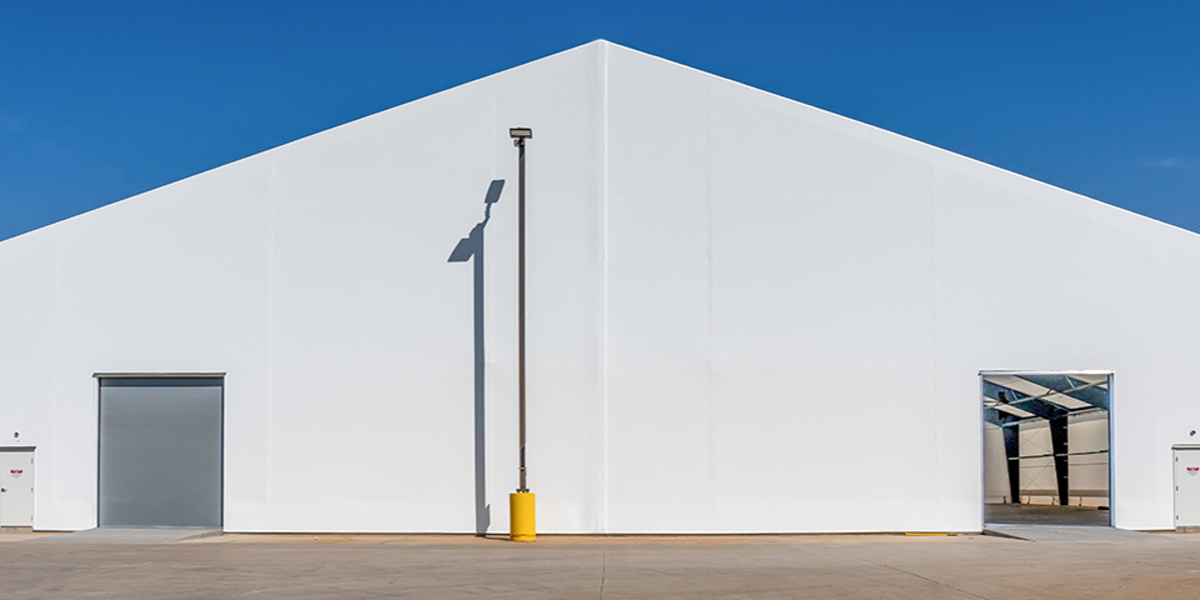Achieving Optimal Climate Control with Thermally Non-Conductive Fabric

On a hot day, the desire to stay cool seems all-consuming. Equipment and bulk material – particularly temperature-sensitive items such as commodity crops and waste matter – also thrive in a cooler environment. Keeping stored material cool prevents spoilage and slows the growth of harmful mold and bacteria.
Air conditioning and cooling systems are an obvious way to keep the interior of a commercial storage structure cooler, however they are expensive and may not be necessary or practical for all applications. But with a few simple building guidelines, it’s easy to provide thermal comfort with no ongoing maintenance.
Provide Shade with a Fabric Building
While shade doesn’t technically create a lower temperature, it does feel cooler. Getting out of the sun’s rays immediately feels cooler than being in direct sunlight. For commercial storage structures requiring extreme ventilation, a simple pavilion structure will make the area feel cooler without disrupting airflow in any direction.
Of course, the sun also provides plentiful (and free) light – the key is striking a balance between too much heat and not enough light. A semi-translucent building material, such as architectural fabric, is the answer. Fabric buildings have abundant light streaming in through the walls and ceiling, providing natural light without dark corners, while deflecting the harsh, hot rays of the sun. Because there’s already plenty of light without adding windows, there are no concentrations of radiant heat – just a consistent, comfortable interior.
Use Fabric Buildings for Less Thermal Conductivity
The commercial storage structure’s cladding dictates the interior temperature, particularly in uninsulated buildings. Building materials with a high thermal conductivity, such as steel, will magnify the outside conditions. Steel has a thermal conductivity level of 43W/(m K)1.
Think of a piece of steel left out in the sun – both sides of the steel are still hot to the touch hours after the sun goes down. The same will be true of a steel building – after sitting in the sun, the steel will turn hot, raising the temperature inside the building.
Fabric, such as Exxotec™ PVC fabric, has thermally non‐conductive properties. While fabric isn’t known for contributing any insulative R‐value to the building, the non‐conductive properties of fabric help to maintain the interior temperature rather than magnifying the outside conditions.
Insulation is installed between two layers of fabric so it is not visible from anywhere in the building. In independent studies, insulated fabric buildings have been shown to be 20% more efficient to heat and cool as compared to similarly insulated metal buildings because of the non‐conductive and airtight qualities of fabric.
Ventilation Options in Commercial Storage Structures
A well-ventilated building will have the effect of a cooling breeze, even without wind disturbing the contents of the building. Passive ventilation systems use gravity and natural means to achieve air circulation.
The best way to feel the cooling effects of ventilation is to keep cool air flowing in at a low level, where it will be felt by people or objects inside, while exhausting hot air high overhead. You probably remember learning that heat rises – while this isn’t technically accurate, it’s true that hot air will rise above cool air.
Learn more about ventilation options in fabric structures.
With a custom engineered fabric building, ventilation is achieved through whatever means are best for you. A common method is to combine mesh panels under the overhang with peak exhaust vents. This keeps cool air coming in at the eave strut, where it will be felt inside, and moves hot air to the top of the building and eventually back outside.
Even in cold or temperate climates, it’s smart to design a commercial storage structure that stays naturally cooler. By making a few smart choices, you’ll be protecting stored material from the effects of extreme heat.
Ready to get started with an energy-efficient fabric structure? Request a quote today.
1The Engineering Toolbox. “Thermal Conductivity of Some Common Metals and Gases.” Web. 28 July 2015. http://www.engineeringtoolbox.com/thermal-conductivity-d_429.html
Subscribe to our Blog
Recent Posts
- 5 Factors Every Project Owner Should Consider Before Approving Building Materials
- The 20-Year View: How Material Choices Impact Long-Term Operational Costs
- Climate Resilience in Commercial Construction: Why Traditional Methods May Not Be Enough
- Speed and Quality: The Role of Hybrid Building Materials
- Beyond the Bleachers: Designing Visually Striking Sports Facilities
